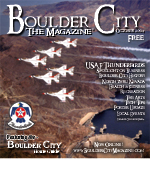
|
|
Boulder City - The Magazine® October, 2004 Issue
|
Cover Story
by Brad and DeAnne Appleby
U.S. Air Force Thunderbirds
In 1947, the Air Force was created as a separate service, and in 1953, the Air Force’s official air demonstration team was activated at Luke Air Force Base near Phoenix, Arizona. It was known as the 3600th Air Demonstration Unit, but shortly after its formation took the name “Thunderbirds,” a name synonymous with the influential Indian culture and folklore of the southwestern United States. Thunderbirds was also a name I was proud to represent during my final tour of duty with the Air Force.
Officially, the Thunderbirds main mission is to “Support U.S. Air Force recruiting and retention programs and to reinforce public confidence in the U.S. Air Force and demonstrate to the public the professional competence of Air Force professionals.” However, to me, the mission was to represent my country by providing an example of the very best that our Air Force has to offer.Needless to say, military personnel who apply and are accepted for positions with the Thunderbirds are exceptional in their fields of expertise. The 12 pilots are officers who have a minimum of 1,000 hours of military jet experience and the support staff are 120 enlisted persons who reflect the highest standards of the Air Force. Military personnel are not “assigned” to the team; there is an arduous application process consisting of a severe credential review, a required recommendation and many other evaluation criteria. It was surely the hardest job to get, but the most rewarding job of my military career. Officers serve for two years, and enlisted persons serve for three years. Each year, one half of the team changes, allowing the new recruits to be “broken in” by the current team.
The Thunderbirds utilize 12 Lockheed Martin F-16 Fighting Falcon jets, which are compact, multi-role fighter aircraft. Most people don’t know what color the Thunderbird jets really are: Thunderbird Red, Thunderbird White and Thunderbird Blue!
The Thunderbirds perform most weekends from mid-March to mid-November; about 70 air shows at 40 different locations across the United States. The intense training season is from mid-November to mid-March. The Thunderbird team deploys for an air show on Thursday, practices on Friday, and performs for the public on Saturday and Sunday. During their “spare time,” team members perform public relations duties such as visiting schools and hospitals, and other public relations events. I’ll never forget my first PR assignment: the Junior High School in Boulder City with Officer Dale Wood. The show season is so grueling that before a member can be accepted on the team, their spouses must supply written waivers acknowledging their understanding that the duty time and effort required for the job is above and beyond any job in the Air Force, and will require lots of extra time away from home.
|
|
|
Care for a ride in an F-16 Fighting Falcon? To qualify for an orientation flight, you must be an accredited member of the media, recommended by Air Force recruiters and air show sponsors, and reviewed and approved by the Thunderbirds. After all, orientation flights are a tool of the Air Force to generate national media coverage and convey a positive image of the Air Force.
There is one other way to experience this thrill. Enlisted team members are entitled to an “incentive flight.” My flight was an experience that I will never forget. In fact, with the help of the on-board cameras, I am free to enjoy the video tape of my flight any time! (You can see the video by clicking on the photo below.) The pilot and I settled into the two-seater jet used for these flights and we were off. After doing a vertical takeoff, the pilot rolled the jet over for a spectacular view of the Las Vegas Valley. Afterwards, it was my turn to fly. With the help of the pilot, I took us through several of the maneuvers done in a typical air show, such as a loop, a spin, and an incredible four-point roll. The pilot then resumed control and took us through a max 360 turn, during which we pulled 9.2 gravity-force (the equivalent of 9.2 times your body weight being pressed against you). Upon landing, I realized that there is a lot more work to being a pilot than I had anticipated, and I had a new respect for our Air Force pilots.
As local residents, we are fortunate to catch the tail end of every show season with an air show at Nellis each November. Currently, the team is on a tour of the Far East, only the fourth in its history, but they will be back in time for the show at Nellis. Be sure to attend and experience these awesome showmen at work, and at the same time, enjoy the Thunderbird museum and incredible Thunderbird hangar at Nellis.

Click on the photo to view Brad's flight video.
|
 Boulder City - The Magazine®
Boulder City - The Magazine®
688 Wells Rd #A
Boulder City, Nevada 89005
(702) 293-4916 or (702) 294-1392
E-mail: BoulderCityMagazine@gmail.com

Web Site Design by Appleby Arts
Copyright © 2004 - Boulder City-The Magazine - All Rights Reserved
E-mail Web Master at: webmaster@bouldercitymagazine.com
Disclaimer
|








